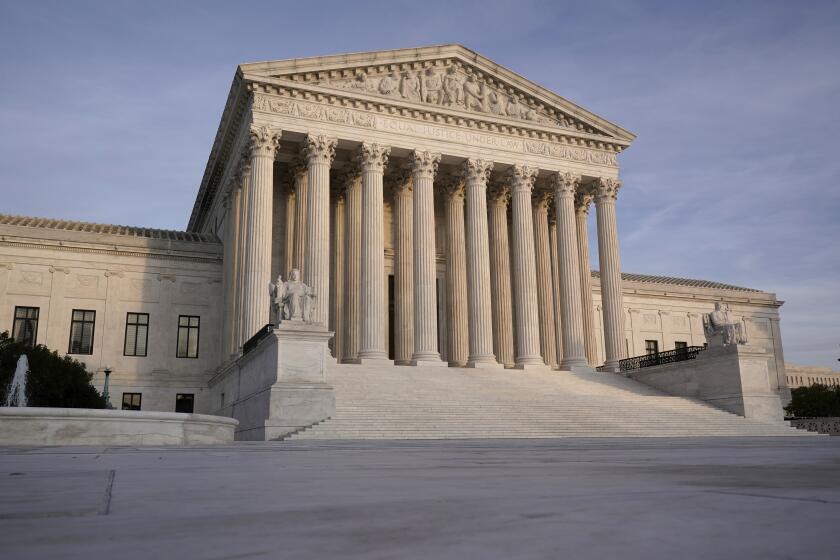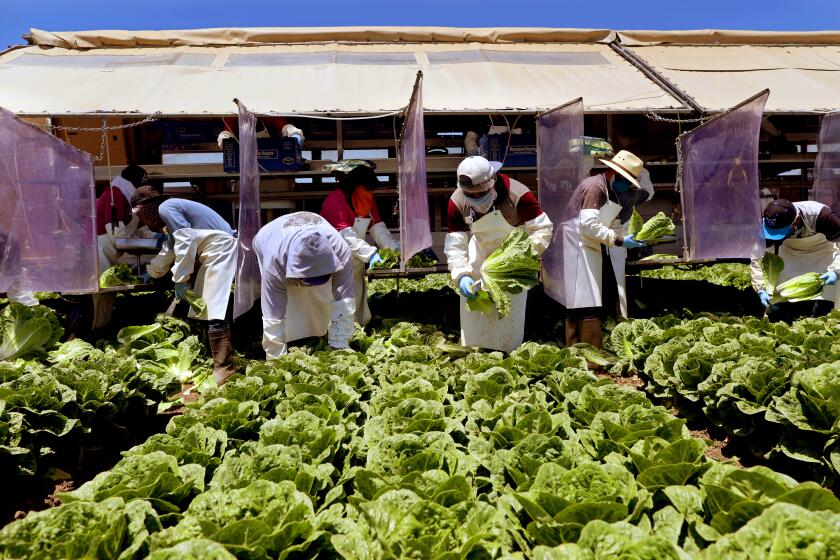OSHA has long failed to protect some of our most vulnerable workers

- Share via
The Supreme Court decision that killed the federal vaccine-or-test rule for large businesses is a defeat for employee health and safety. But even aside from the COVID-19 pandemic, the federal government doesn’t devote sufficient resources to protect workers in high-risk environments.
The agency that monitors workplace conditions, the Occupational Safety and Health Administration, has the authority to send investigators to workplaces known to expose workers to occupational hazards and, if warranted, issue citations and levy substantial fines on business owners.
Yet, OSHA has only sparingly applied this authority to some of the country’s most dangerous workplaces.
The decision to block the OSHA vaccine-or-test requirement could be the first salvo in a full-scale attack on the administrative state.
Meatpacking plants, factories and greenhouses employ many of America’s lowest paid and most vulnerable workers. Many are immigrants and people of color laboring in crowded or otherwise hazardous conditions. The pandemic has shown how the front-line, essential work done by this “brown-collar” workforce is critical to keeping the economy and communities going. Yet on top of being at high risk of COVID-19 illness and death, these workers have always been exposed to higher occupational health and safety risks than those in other industries.
Long before the pandemic, greenhouse workers — such as those handling the hothouse tomatoes that brighten many American salads — suffered from a slew of health and safety violations, including lack of protective gear for handling toxic chemicals and lack of water breaks in temperatures above 100 degrees. When COVID-19 hit, greenhouses in Cochise County, Ariz., for example, did not require virus-related precautions, as my clinic learned while providing legal services to workers.
OSHA investigations are virtually unheard of in these and comparable workplaces. An October congressional hearing on COVID-19 infections and deaths among meatpacking workers at the country’s top five meatpacking companies revealed that at least 59,000 meat industry workers were infected with the virus during the first year of the pandemic and 269 died as a result. Among the horrors recounted at the hearing were stories of workers being given just one mask each and having to pull it down or remove it when it became spattered with blood.
While the hearing highlighted COVID-19 risks at these plants, the work conditions of meatpacking — such as rigorous production quotas, crowded spaces and continuous repetitive motion with little respite — have long been hazardous, causing accidents, musculoskeletal disorders and exposure to chemical and biological hazards. Nevertheless, there was little accountability for these and other high-risk workplaces even before the pandemic.
Indigenous farmworkers are dying from COVID-19, as they lack resources to explain the disease or its treatment in their native languages.
One reason for this lack of enforcement is that OSHA does not have enough investigators. As of 2020, the agency had fewer investigators than at any time since 1975. This limits it to investigating a tiny fraction — under 40,000 annually — of the approximately 7 million workplaces OSHA is supposed to oversee. Even in 2004, when OSHA conducted substantially more investigations than it does now, the probability that a covered workplace would receive an investigation in any given year was below .001.
In 2020, the National Employment Law Project estimated that, at current staffing levels, it would take OSHA 165 years to inspect each of the workplaces under its jurisdiction just once.
But there is another, subtler reason OSHA does not issue more citations to high-risk workplaces: Like many agencies, it relies on worker complaints to determine which places to investigate.
The most vulnerable workers, however, rarely complain because of the ever-present threat of retaliation. Employers are known to punish those workers who dare to assert their rights with demotion, termination and immigration enforcement. This makes it unlikely that those workplaces most inclined to violate OSHA rules will be investigated and penalized.
And worker complaints do not always resolve safety concerns. In July 2020, meatpacking workers at a Maid-Rite plant in Pennsylvania filed a lawsuit against OSHA alleging it failed to protect them following an “imminent danger complaint” they had submitted about their work conditions, to which the agency first responded with a letter asking Maid-Rite to address the problem itself. (OSHA later investigated and a federal judge dismissed the complaint, though workers reportedly planned to appeal.)
The pandemic and the recent Supreme Court ruling — which did recognize OSHA’s power to regulate hazardous workplaces — offer the agency an opportunity to re-focus limited resources on the health and safety of America’s most vulnerable yet essential workers.
This will not be simple or happen overnight: It will require OSHA to increase its ranks and engage those states that have their own workplace health and safety agencies but are not adequately enforcing the law.
But there is one change OSHA can make immediately: Regularly investigate the industries most likely to harm workers even in the absence of worker complaints. The pandemic proved that the welfare of the nation is inextricably connected to the health and safety of essential workers.
Shefali Milczarek-Desai is associate professor of law, director of the Workers’ Rights Clinic and co-chair of the Bacon Immigration Law and Policy Program at the University of Arizona. @shefalimdesai
More to Read
A cure for the common opinion
Get thought-provoking perspectives with our weekly newsletter.
You may occasionally receive promotional content from the Los Angeles Times.











